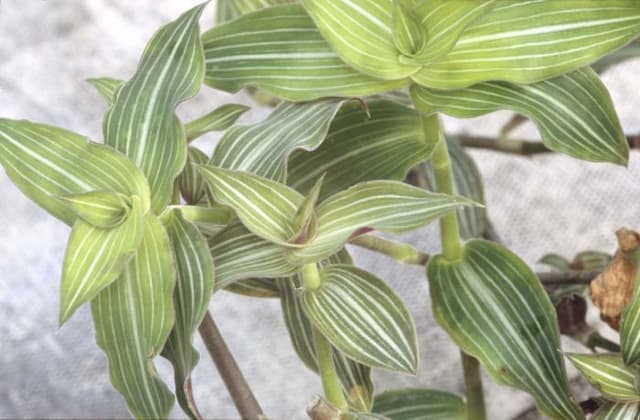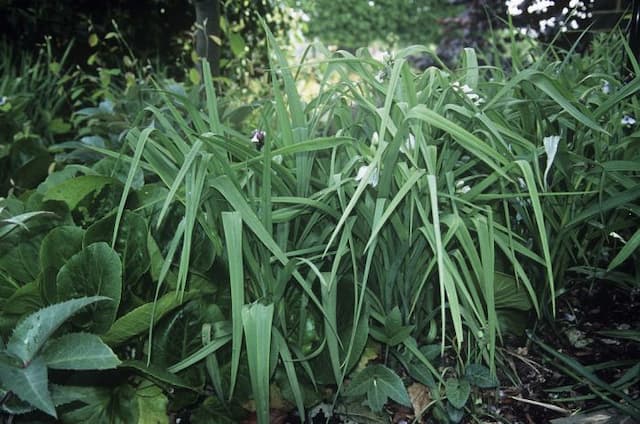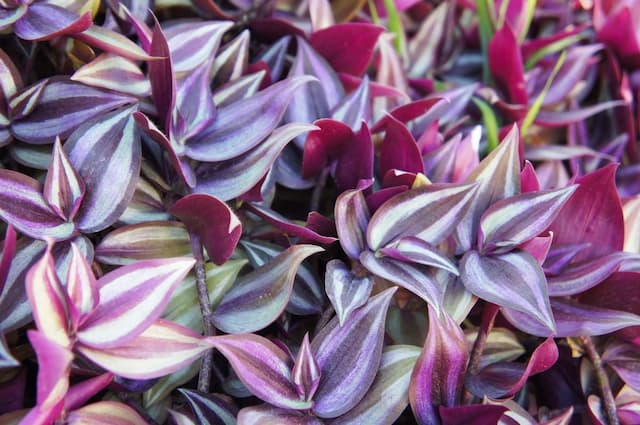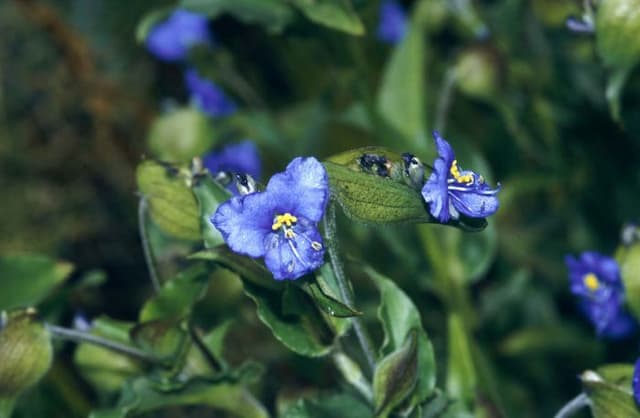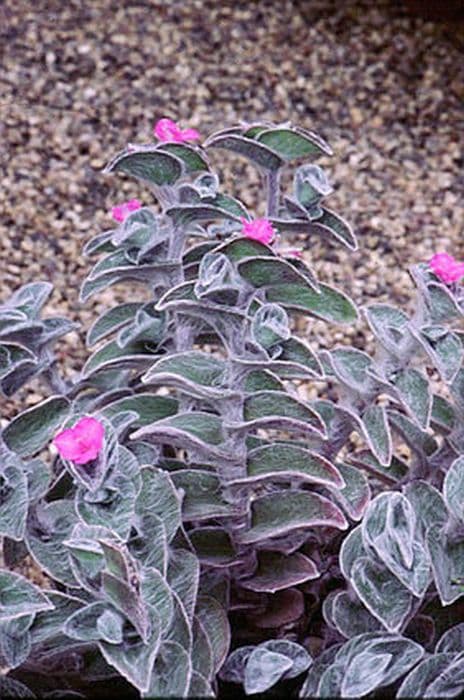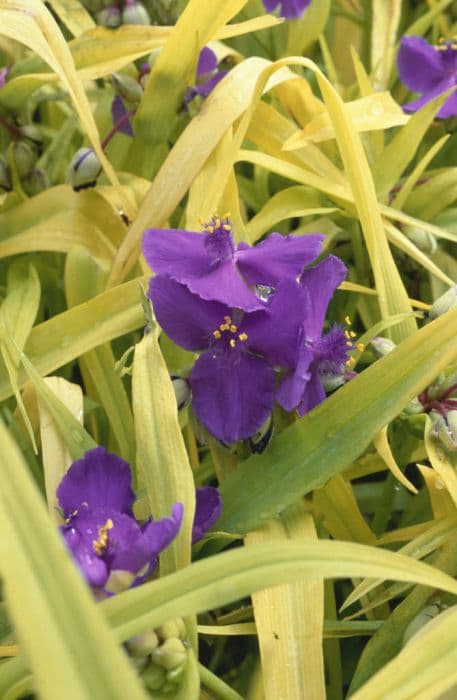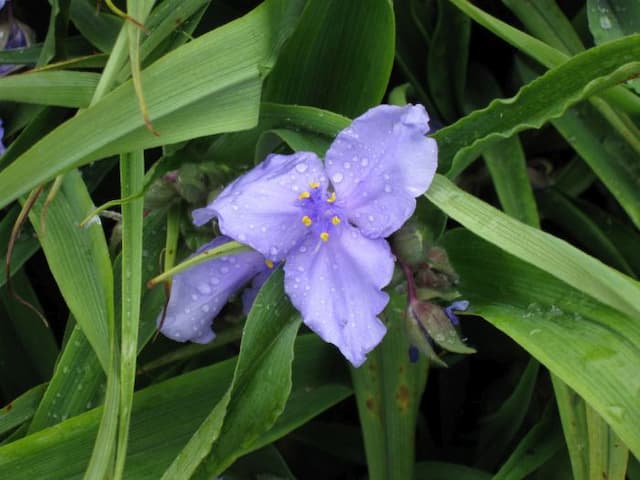Purple heart Tradescantia pallida

ABOUT
The common name for Tradescantia pallida is purple heart. This plant is notable for its striking purple to purplish-pink foliage. The leaves are elongated, pointed at the tips, and exhibit a fleshy, slightly succulent quality. Texture-wise, each leaf feels smooth to the touch and has a sheen that highlights its rich coloration. The stems of the purple heart are also purple, tending to grow in a trailing or spreading fashion that allows the plant to cover ground elegantly. Throughout the growing season, small, three-petaled flowers emerge directly from the stems, typically displaying a pale purple hue that complements the deeper tone of the foliage. The overall appearance of the plant is lush and vibrant, making it a popular choice for gardeners looking to add a splash of color to their landscaping or indoor décor.
About this plant
 Names
NamesFamily
Commelinaceae.
Synonyms
Purple Heart, Purple Queen, Wandering Jew, Purple Secretia.
Common names
Setcreasea pallida, Setcreasea purpurea, Tradescantia purpurea.
 Toxicity
ToxicityTo humans
The plant known commonly as Purple Heart is not considered highly toxic to humans. However, ingestion of this plant may cause mild irritation in the mouth, stomach upset, or possible vomiting. It is not generally considered to be serious, but if large amounts are consumed or if an individual has a particular sensitivity, it may result in more discomfort and digestive issues.
To pets
For pets, the Purple Heart plant can be somewhat more problematic. While it is not considered highly toxic to cats and dogs, it can still cause gastrointestinal upset such as vomiting or diarrhea if ingested. In some cases, pets may also experience drooling or show signs of oral irritation. It is advisable to keep this plant out of reach of pets to prevent any potential discomfort or adverse reactions.
 Characteristics
CharacteristicsLife cycle
Perennials
Foliage type
Evergreen
Color of leaves
Purple
Flower color
Pink
Height
1-2 feet (0.3-0.6 meters)
Spread
1-2 feet (0.3-0.6 meters)
Plant type
Herb
Hardiness zones
8-11
Native area
Mexico
Benefits
 General Benefits
General Benefits- Low Maintenance: Purple heart is known for being relatively easy to care for, which makes it suitable for gardeners of all skill levels.
- Drought Tolerance: Once established, this plant is quite tolerant to drought, reducing the need for frequent watering.
- Rapid Growth: It has a fast growth rate, which allows it to quickly fill in spaces in the garden or home.
- Groundcover: Due to its spreading habit, purple heart can function as a groundcover, helping to prevent soil erosion.
- Attracts Pollinators: Purple heart's flowers can attract butterflies and other pollinators to your garden.
- Color Addition: Its striking purple foliage adds a pop of color to otherwise green landscapes or indoor spaces.
- Edging Plants: Due to its growth habit, purple heart works well as an edging plant along paths or flower beds.
- Container Gardening: It is suitable for pots and containers, offering versatility in placement and design.
 Medical Properties
Medical PropertiesThis plant is not used for medical purposes.
 Air-purifying Qualities
Air-purifying QualitiesThis plant is not specifically known for air purifying qualities.
 Other Uses
Other Uses- Tradescantia pallida, commonly known as Purple Heart, can be used as a natural dye, providing a range of purple hues when the leaves are processed correctly.
- The sap of the Purple Heart is sometimes used in folk art for its adhesive properties to create collages or mixed-media projects.
- Because of its vibrant color and rapid growth, Purple Heart can be employed as a living mulch to suppress weeds and retain soil moisture in garden beds.
- When dried and crushed, the leaves of Purple Heart can be used as a pigment in homemade paints or pastels for art projects.
- Purple Heart is occasionally used in terrariums or fairy gardens, providing a rich purple backdrop and contrasting foliage.
- In educational settings, the Purple Heart plant can be used to demonstrate vegetative propagation techniques to students.
- The Purple Heart is utilized by horticulturists and breeders as a genetic source for hybridization to develop new ornamental plant varieties.
- For photographers or set designers, Purple Heart can be a valuable prop to create lush, exotic, or fantastical settings due to its intense coloration.
- Its sprawling growth habit makes the Purple Heart ideal for use in hanging baskets or as a spiller plant in container gardens.
- Plant enthusiasts sometimes use Purple Heart to practice shaping and training techniques, similar to bonsai, for ornamental display.
Interesting Facts
 Feng Shui
Feng ShuiThe Purple Heart is not used in Feng Shui practice.
 Zodiac Sign Compitability
Zodiac Sign CompitabilityThe Purple Heart is not used in astrology practice.
 Plant Symbolism
Plant Symbolism- Resilience: Tradescantia pallida, more commonly known as the Purple Heart, is a plant that has the ability to thrive even in conditions that are less than ideal. This attribute leads to its symbolism for resilience and endurance.
- Transformation: The Purple Heart plant can regenerate and root easily from cuttings. This characteristic symbolizes transformation and the ability to adapt to new environments.
- Gratitude: The rich purple color of the leaves is sometimes connected with a sense of thankfulness in the language of flowers, which can be a symbolic message when giving this plant as a gift.
 Water
WaterPurple Heart, commonly known as Tradescantia pallida, thrives when the soil is kept evenly moist but not waterlogged. Water your Purple Heart deeply until water runs out of the drainage holes, usually once per week, but adjust the frequency based on temperature and light; more water may be required during hot, dry periods or when the plant receives more light. During the winter, water less frequently, allowing the top inch of soil to dry out between waterings. Typically, using about 8-16 ounces of water will suffice, based on the size of the pot.
 Light
LightPurple Heart prefers bright, indirect light to maintain its vibrant foliage color. It can tolerate some direct morning or late afternoon sun, but too much direct sunlight can scorch the leaves. An east or west-facing window with filtered light is an ideal spot for this plant.
 Temperature
TemperaturePurple Heart plants thrive in temperatures between 60 and 80 degrees Fahrenheit. They can tolerate a maximum temperature up to 85 degrees Fahrenheit and a minimum of 50 degrees Fahrenheit, but they perform best when kept within their ideal range. Protect the plant from drafts and drastic temperature changes for optimal health.
 Pruning
PruningPurple Heart should be pruned to encourage bushier growth and to maintain a desirable shape. Prune the tips or pinch back the stems to promote branching, ideally during the spring or early summer for the best results. Regular pruning, every couple of months during the growing season, can also help remove any leggy or wilted parts and enhance the plant's appearance.
 Cleaning
CleaningAs needed
 Soil
SoilPurple Heart (Tradescantia pallida) prefers a well-draining soil mix consisting of a combination of peat, perlite, and compost in equal parts; the ideal soil pH for Purple Heart ranges from slightly acidic to neutral (pH 6.0-7.5).
 Repotting
RepottingPurple Heart should typically be repotted every 2-3 years or when it has outgrown its current container, showing roots through the drainage holes.
 Humidity & Misting
Humidity & MistingPurple Heart thrives in moderate to high humidity conditions, ideally between 40-50%, but it can tolerate lower humidity levels commonly found in homes.
 Suitable locations
Suitable locationsIndoor
Provide bright, indirect light and keep soil moist for Purple Heart.
Outdoor
Place Purple Heart in partial shade; avoid intense afternoon sun.
Hardiness zone
8-11 USDA
 Life cycle
Life cycleTradescantia pallida, commonly known as Purple Heart, starts its life cycle as a seed, which germinates in warm, moist soil. Upon germination, it develops roots and shoots, soon forming a juvenile plant with distinctive elongated leaves. As it matures, the Purple Heart grows quickly, forming sprawling stems that can root at the nodes where they touch the soil. It then reaches the flowering stage, where small three-petaled pink or purple flowers bloom, mainly in the summer. After pollination, these flowers produce small capsules containing seeds, completing the sexual reproduction cycle. Additionally, this plant can propagate vegetatively through stem cuttings, which root easily when planted in soil, thus contributing to its spread and the continuation of its life cycle.
 Propogation
PropogationPropogation time
Spring to Summer
The most popular method for propagating the Purple Heart (Tradescantia pallida) involves stem cuttings, which can be taken nearly any time of the year, though growth is most active during the spring and summer. You'll want to choose a healthy section of the plant, ideally a stem that's 4 to 6 inches (about 10 to 15 centimeters) long, with a few leaves. Using a clean, sharp pair of scissors or pruning shears, cut just below a node, which is the point where a leaf or bud is attached to the stem. Then, remove the leaves from the bottom half of the cutting to prevent rot when placed in soil or water. You can place the cutting directly into moist potting soil or first let it root in water, changing the water regularly to keep it clean. Roots typically begin to form within a week or two, at which point the cutting can be transplanted into soil if it was started in water.
